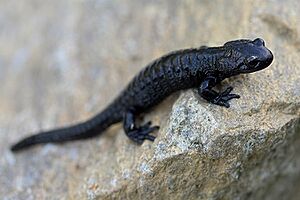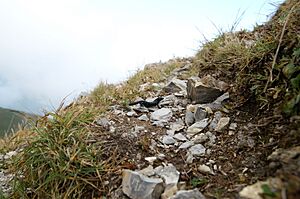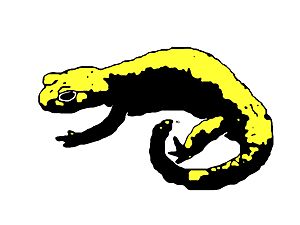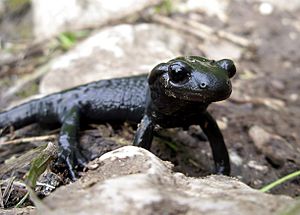Alpine salamander facts for kids
Quick facts for kids Alpine salamander |
|
|---|---|
 |
|
| Conservation status | |
| Scientific classification | |
| Genus: |
Salamandra
|
| Species: |
atra
|
 |
|
The alpine salamander (Salamandra atra) is a cool black salamander. You can find it in the French Alps and other mountains across Europe. Its name, atra, comes from a Latin word meaning "dull black." Over time, some alpine salamanders became completely black. Others developed yellow spots and marks. These salamanders can live for at least 10 years.
There are four types, or subspecies, of the alpine salamander. They live in different places and have different colors. Unlike many other salamanders, alpine salamanders are fully land animals. Their babies develop inside the mother and are born alive on land. Alpine salamanders also make special toxic stuff on their skin. This helps protect them from predators and tiny germs.
Contents
What Does the Alpine Salamander Look Like?
Alpine salamanders are usually small. They are often dark brown or black. But not all of them are just one color. Some have cool mosaic or spotted patterns. For example, a type called Salamandra atra aurorae has bright spots. These spots are usually yellow. They can also be white or gray. The spots can look smooth or patchy. This depends on how their color cells are spread out.
Female alpine salamanders are usually bigger than males. Females can grow up to 151 millimeters (about 5.9 inches) long. Males grow to about 144 millimeters (5.6 inches). Both these sizes include their tails. Males have a swollen area called a cloaca that you can see. They also look thinner than females. These salamanders have special glands behind their eyes. These glands make their heads look longer. They usually have 11 to 13 grooves along their sides. They also have two rows of glands down their backs. These glands go all the way to their tail tips.
How Do Alpine Salamanders Get Their Color?
Most alpine salamanders are completely black. This dark color has a long history. Scientists have studied if they started black or changed over time. DNA studies suggest they became black over time. This happened through many generations.
An animal's color comes from special cells. These cells are called chromatophores. They absorb or reflect light in certain ways. This makes them appear as a color. In alpine salamanders, different cells make different colors. Melanophores make the dark color. They produce a dark pigment called melanin. Xanthophores make yellow pigment. Iridophores just reflect light.
The completely black salamanders have only melanophores. These cells make melanin in their skin. Salamanders with yellow spots have other cells too. They have melanophores, xanthophores, and iridophores. These work together to make bright yellow spots. Some salamanders never develop these yellow cells.
The yellow color on some alpine salamanders is a warning. It tells predators, "I might be poisonous!" This is called aposematism. Being pure black might also help them control their body temperature. It could also be a warning sign to some animals.
Types of Alpine Salamanders
There are a few different types of alpine salamanders. They are called subspecies.
- S. a. atra is completely black. It lives in the central, eastern, and Dinaric Alps. This type is the most common.
- S. a. aurorae, also called the golden alpine salamander, has golden or yellow spots. It lives in a small area in the Venetian Prealps near Asiago, Italy.
- S. a. pasubiensis has fewer yellow spots than S. a. aurorae. It lives in a different part of the Venetian Prealps.
- S. a. prenjensis lives on Prenj Mountain. This mountain is in Bosnia and Herzegovina. Scientists are still checking if this type is its own species.
Scientists think the Corsican fire salamander is a close relative. They believe the black-yellow color was an original feature. The all-black S. a. atra spread after the last ice age.
Where Do Alpine Salamanders Live?

What is Their Habitat Like?
These salamanders live only on land. They like to hide under stones or logs. They also use rocky cracks in their mountain homes. Alpine salamanders are active during the day. They rest or sleep at night. But they might be active at night if the weather is right. They like rainy weather or after it has rained. The best temperatures for them are between 3 and 18 °C (37.4 and 64.4 °F).
Where Are They Found?
The alpine salamander lives from the France–Switzerland border all the way to Austria. Their territory reaches the Dinaric Alps in the east. They usually live high up in the mountains. This is often above 700 metres (2,300 ft) (about 2,300 feet) above sea level. They can even be found at 2,000 metres (6,600 ft) (about 6,500 feet) high.
A similar species, Lanza's alpine salamander, lives in the western Alps. Alpine salamanders generally live in forests. They especially like mixed forests with deciduous and coniferous trees. They can also live in mountain meadows or grasslands. They do well with different types of trees.
Their range covers many countries. These include Slovenia, Croatia, Bosnia, Herzegovina, Montenegro, Kosovo, France, Italy, and Austria.
Home and Territory
They love forests with silver fir and beech trees. Coniferous forests with Norway spruce and European larch trees are also good homes. Even though these are tree forests, the salamanders live on the ground. Since they are fully land animals, they have territories on land. They tend to return to these spots often. They use them for shelter during the day and night.
They often go back to the same hiding spots for most of their lives. When they leave their spots, they risk being caught by predators. They also risk losing their safe place. Alpine salamanders are ectothermic. This means their body temperature depends on their surroundings. Losing a shelter can be very dangerous for them. It could even be deadly.
Because they rely so much on a good hiding spot, scientists think they protect their territories. Studies show they don't move far. The farthest one traveled was 12 metres (39 ft) (about 39 feet) in a summer. Many salamanders can live in suitable areas. Over 2000 individuals per hectare have been seen. This means there are many of these hidden creatures.
How Do They Mark Their Territory?
Alpine salamanders use scent-marking to mark their territories. They use their poop pellets to do this. This helps them find their own shelters. Scent-marking is a way for salamanders to talk to each other. Chemical signals tell other S. atra where they are. Alpine salamanders can tell if a poop pellet was left by another salamander of the same sex or species. This warning tells other salamanders that the spot is already taken.
Female salamanders are more likely to return to their home spot. Males are more likely to go into another male's territory. Their poop pellets help them find their way home. They also help them know if there are intruders.
Protecting Alpine Salamanders
Alpine salamanders are not good at handling changes to their homes. Few land salamanders are. So, climate change is a big risk to them. Even though they are listed as Least Concern on the IUCN Red List, their numbers are going down. Some types of alpine salamanders are in more danger. For example, the numbers of S. a. aurorae are decreasing.
One of the biggest dangers is cutting down trees in their habitats. This is called deforestation. Big machines like tractors can squish the soil. This gets rid of small insects that salamanders eat. It also destroys their hiding spots. Many scientists suggest changes in the lumber industry to help. These salamanders might also change their bodies (morphology) as global temperatures rise. Amphibians cannot control their body temperature. They might need to adapt to stay at a good temperature. Other problems like acid rain could force them to new homes. Alpine salamanders are important in their ecosystems. Europe already has conservation laws. But many experts suggest more laws to protect these animals and plants.
What Eats Alpine Salamanders?
Alpine salamanders are poisonous. Also, fewer animals live at high altitudes. So, scientists are not sure what consistently eats them. They move slowly, which could make them easier to catch. Generally, predators of poisonous salamanders include birds, rats, and snakes. Larger mammals like raccoons, minks, wild boars, and foxes might also eat them.
Young snakes are a known predator. Especially young European adders (Vipera berus). They live in the same high places as alpine salamanders. In some areas, alpine salamanders make up almost half of these snakes' diets. The snakes might hunt them in the early morning. This is when alpine salamanders are most active. There is also proof that these snakes swallow alpine salamanders. V. berus and the grass snake (Natrix natrix) eat alpine salamanders in the Italian Alps.
What Do Alpine Salamanders Eat?
Male and female alpine salamanders eat pretty much the same things. They hunt for beetles, snails, millipedes, and spiders. But they do have favorite foods. They mostly eat beetles and mollusks (like snails). These are the most important parts of their diet. They also tend to eat larger prey. This is because they are larger salamanders themselves. This means they choose food that gives them the most energy. Even though they have favorite foods, their diet can change a lot. This helps them get the nutrients they need. It also depends on what prey they can catch.
Babies and Reproduction
Alpine salamanders have an equal number of males and females. They mate on land. The male holds the female by her front legs. The eggs are fertilized inside the female. S. atra are viviparous. This means their young are born alive. They do not go through metamorphosis like many other amphibians. They usually give birth to 2 babies. Sometimes they have 3 or 4. New baby salamanders can be as long as 50 millimetres (2 in) (about 2 inches) at birth. The mother might only be 120 millimetres (4.7 in) (about 4.7 inches) long.
Female alpine salamanders have a special uterus. The eggs inside are large and many. But usually, only one baby fully develops in each side of the uterus. The baby salamander eats the yolk of the other eggs. These other eggs dissolve into a big mass of food. This egg mass can be between 25 mm and 40 mm long. The baby salamander goes through three stages:
- First, it stays inside its egg and eats its own yolk.
- Second, it is free inside the yolk mass. It eats the yolk directly with its mouth.
- Third, there is no more yolk mass. The baby grows long external gills. These gills help it get food from the mother's uterus. They work like the chorionic villi in mammals.
At lower altitudes (650–1,000 metres (2,130–3,280 ft)), a pregnancy lasts two years. At higher altitudes (1,400-1,700 m), it lasts about three years. But anywhere from 2 to 4 years is normal. Alpine salamander babies are unique. They can get nutrients from the mother for a long time. After eating the unfertilized eggs, they eat cells from the mother's uterine wall. This is called epitheliophagy. They have special tooth-like parts to do this. This does not harm the mother.
How Alpine Salamanders Work
Glands and Toxins
As mentioned, alpine salamanders have poison glands. They make certain chemicals called alkaloids and peptides. These give them a mustard-like smell. Scientists are still learning about how Salamandra species make these chemicals. Salamandarines are chemicals made by the skin of alpine salamanders. They are also found in some fire salamanders. These are neurotoxins. This means they affect nerves. They are made inside the salamander's body. They don't come from eating poisonous things. The main ingredient for this nerve-blocker is likely cholesterol. It is about twice as strong as cyanide.
This toxin is not just for paralyzing prey. It might also help protect them from bacterial and fungal infections. Salamandorone is another chemical made by S. atra. It is less strong against prey. But it is the strongest germ-fighting weapon these salamanders have.
Scientists study two main types of toxins: samandarine and samandarone. There are also many other chemicals. Both samandarine and samandarone are made by S. atra. Samandarine is thought to be more for defense against predators. Samandarone is made when there is a higher risk of infection. The amount of toxin produced can also vary depending on where the salamander lives.
How They Fight Sickness
Samandarone, a toxin from their skin, can fight germs. One study found this toxin where there was infection risk. But it was in low amounts. S. atra makes many toxins. Many of them fight germs. Some might even be building blocks for other protective chemicals.
The alpine salamander has been lucky. It has mostly avoided a dangerous fungal infection. This infection is called amphibian chytrid fungus. It is caused by Batrachochytrium dendrobatidis (Bd). This fungus has wiped out amphibian populations everywhere. Bd is found in the Alps where alpine salamanders live. But in a 2012 study, no salamanders tested positive for it. This might be because Bd infections are more common in water-dwelling species. Since alpine salamanders live on land, they are less likely to get it. Another idea is that S. atra are immune. This could be because of their skin germs or a chemical they make. This idea hasn't been fully tested. But it's possible, since many salamanders make biological toxins.
Images for kids
-
The alpine salamander in Schoppernau, Austria.














